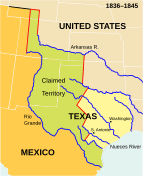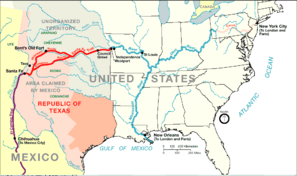Texan Santa Fe Expedition facts for kids
The Texan Santa Fe Expedition was a journey made by Texans in 1841. Their goal was to claim parts of New Mexico for the Republic of Texas. Texas President Mirabeau B. Lamar started this trip. He hoped to control the busy Santa Fe Trail, which was important for trade. He also wanted New Mexico to become part of Texas. Lamar dreamed of making Texas a powerful country. He believed this had to happen quickly to stop people from wanting Texas to join the United States. Before the expedition, Texas had already tried to talk to New Mexicans. Many Texans thought the people of New Mexico would want to join them.
Contents
The Journey Begins
The expedition started on June 19, 1841, from Kenney's Fort near Austin. They had 21 wagons pulled by oxen. These wagons carried goods worth about $200,000. The group included merchants who were promised safe travel for their goods. There were also important officials called commissioners, like William G. Cooke and José Antonio Navarro.
Even though it was called a trading trip, a military group of about 320 men went along. This military escort was led by Hugh McCleod. They even had an artillery company with cannons.
Challenges on the Trail
The journey to New Mexico in the summer was very hard. The group was not well prepared. They faced attacks from Native American groups and often ran out of supplies and fresh water. They also lost their Mexican guide. No one knew how far Santa Fe was, and they struggled to find their way. Because of these problems, McCleod had to split his group. He sent an advance team ahead to find the best route.
Arrival and Capture
The expedition finally reached New Mexico in mid-September 1841. But things did not go as planned. Some of their scouts, including Captain William G. Lewis, were captured. The Texans expected a warm welcome. Instead, they met about 1500 Mexican soldiers sent by Governor Manuel Armijo of New Mexico.
One of Armijo's relatives, who spoke English, talked with the Texans. Captain Lewis also spoke, supporting what the relative said. They promised the Texans safe passage and an escort to the border. Lewis even swore on his Masonic faith that it was true. The Texans were exhausted from their difficult journey. They were in no condition to fight such a large army, so they surrendered. The New Mexicans gave them some supplies.
However, the next morning, Governor Armijo arrived with his army. He had the Texans tied up and treated them badly. Armijo wanted to kill the Texans. He asked his officers to vote on it. That night, the prisoners heard the officers debating. By just one vote, they decided to spare the Texans' lives.
Prisoners of War
The Texans were then forced to march 2,000 miles from Santa Fe all the way to Mexico City. During the winter of 1841–42, they were held as prisoners at the Perote Prison in Veracruz. The United States government worked to get them released.
On June 13, 1842, the Texans who survived were finally set free. One of the prisoners, Robert D. Phillips, wrote to his father about their release. Many men waited for a group led by a man named Cook. Then they traveled to Vera Cruz and later to New Orleans. They sailed on different ships, including the Henry Clay. This ship arrived in New Orleans on September 5, 1842, carrying 47 "Volunteers of the Texan Army Santa Fe Prisoners."
Native American Involvement
In the early 1840s, New Mexico asked Puebloans to help stop Texas from expanding its borders. In 1843, this effort greatly affected the Taos Indians. They were forced to join the fight against the Texas invaders.
What Happened Next
Captain Lewis, who had helped with the surrender, was seen as a traitor by many Texans. However, the Texans had few choices. Fighting would have meant they were all killed. It's also not clear if Lewis or the Mexican relative knew Armijo's true plans. The relative, Manuel Chaves, always said he acted honestly with the Texans.
President Lamar was already facing criticism for how he handled the Texan economy. This disaster made his presidency even worse. The expedition clearly showed that Texas did not have enough resources to control its western lands. Most Texans were born in the United States and were not very excited about Lamar's big plans. They doubted if Texas could truly be its own country. This failure convinced many to give up on Texas being independent. They believed a young Republic, constantly threatened by Mexico, could not survive alone.
Lamar had boasted about making Texas a great power. But after the expedition, Texans turned to Sam Houston. He was a hero from the Texas Revolution and wanted Texas to join the United States. In 1845, Texas became a state in the U.S.
Border Disputes and War
Texas joining the U.S. changed the border dispute. It was no longer a fight between Mexico and Texas. Now, it was between Mexico and the United States. This, along with how Mexico treated the Texan prisoners, increased tensions. These events helped lead to the Mexican–American War. During the war, Governor Armijo surrendered Santa Fe to the U.S. Army without a fight. Chaves then officially switched his loyalty to the U.S.
The United States won the war. This gave the U.S. full control of all the lands that Texas had claimed. However, Texas faced challenges within the U.S. when it tried to govern these lands. Other Southern states wanted Texas's western claims to be split into new slave states. This would help keep the balance of power in the United States Senate.
The Compromise of 1850
As part of the larger Compromise of 1850, Texas agreed to give up its northwestern land claims. This included the Santa Fe region, which was the main goal of Lamar's expedition. In return, the U.S. government agreed to pay off Texas's state debts. Texas kept its current borders, which was still twice the size of the land it had actually controlled as a Republic. Most of the lands Texas gave up became the New Mexico Territory. Armijo, who returned to New Mexico after the war, died in 1853.
The final decisions about these regions were not made before the American Civil War began in 1861. During the war, the Confederacy tried to control the region. They based their claim partly on the old Texan claims. This conflict put Chaves and the Texans on opposite sides again. Chaves remained loyal to the Union. Texan troops fighting for the Confederacy played a big role in their unsuccessful attempt to control present-day New Mexico. Chaves himself was important in the key Battle of Glorieta Pass.
In Popular Culture
The Texan Santa Fe Expedition has appeared in books and TV shows:
- A Texas Ranger is called a "Santa Fe expeditioner" in the 1860 novel The Lone Ranch: A Tale of the Staked Plain by Capt. Thomas Mayne Reid. This character spent over a year in Mexican prisons.
- The expedition is also the background for Clarence E. Mulford's 1922 novel Bring Me His Ears.
- It is also featured in Larry McMurtry’s 1995 novel Dead Man's Walk. This book was also made into a 1996 TV miniseries, which is part of the Lonesome Dove series.
Images for kids






